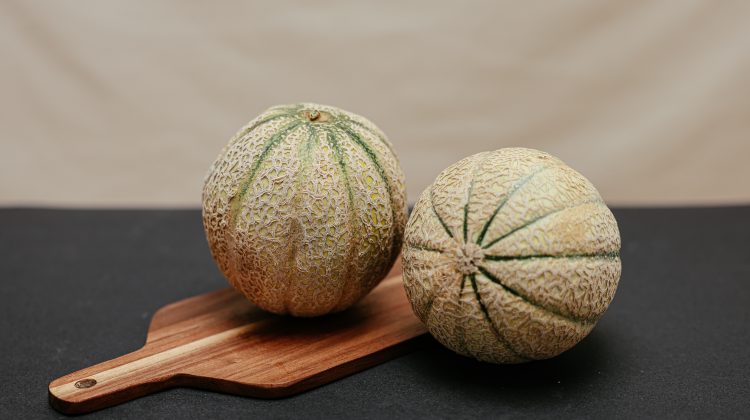
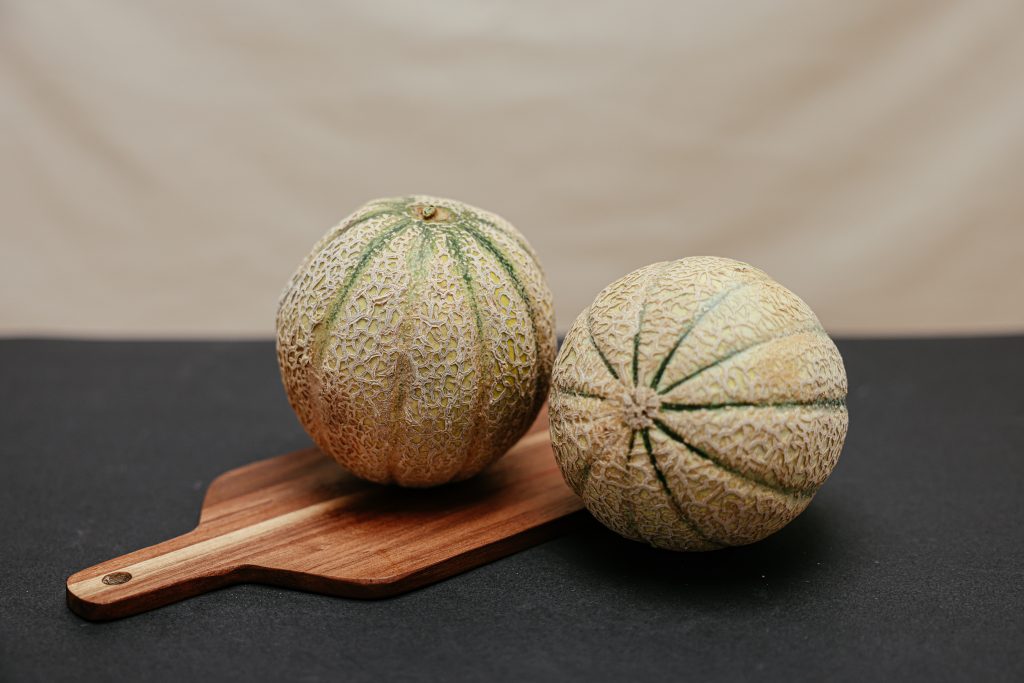
Ripe cantaloupe is a variety of muskmelon that belongs to the cucurbit family, which also comprises cucumbers, pumpkins, and squash. The name “cantaloupe” specifically refers to this type of muskmelon, which has a rough, warty surface and a unique sweet scent.
Originally from the Middle East, cantaloupes were eventually brought to Europe and the Americas.
Today, they are widely cultivated in many countries around the world, with the United States, Turkey, and Iran being the largest producers. Cantaloupes are typically harvested in the summer months and can be enjoyed in a variety of ways, such as sliced or cubed as a snack, used in fruit salads, or even grilled as a side dish. In this blog, we are going to discuss how to select the perfect sweet cantaloupe.
Importance of selecting a ripe cantaloupe
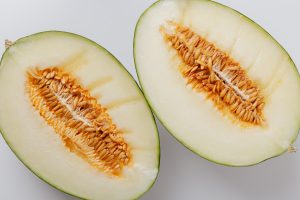
Selecting a ripe cantaloupe is important for several reasons. First and foremost, a ripe cantaloupe will have the best flavor and texture. It will be sweet and juicy, with a tender flesh that is easy to eat. On the other hand, an unripe cantaloupe will be hard and flavorless, while an overripe cantaloupe will be mushy and may have an off taste.
Additionally, selecting a ripe cantaloupe can help you avoid wasting money on fruit that is not at its peak quality. A ripe cantaloupe will also be more nutritious, as it will have a higher concentration of vitamins and minerals compared to an unripe one.
Selecting a ripe cantaloupe can also help you prevent foodborne illnesses that can result from consuming spoiled or contaminated fruit.
Tips on picking the right Cantaloupe
- Examine the skin color: A ripe cantaloupe will have a golden or yellowish color, while an unripe one will be green or pale. The skin should also have a slightly rough texture, with small bumps or ridges that indicate that it’s matured.
- Check the shape of the cantaloupe: A ripe cantaloupe should have a symmetrical shape, without any flat spots or dents. If the fruit is misshapen or has any visible bruises, it may be overripe or damaged.
- Smell the fruit: A ripe cantaloupe should have a sweet, fragrant aroma, which indicates that it’s ready to eat. If the fruit doesn’t have any smell or smells slightly sour, it may not be ripe enough.
- Tap the fruit: When you tap a ripe cantaloupe, it should sound hollow. If it sounds dull or thudding, the fruit may not be fully ripe yet.
- Check the stem end: The stem end of a cantaloupe should be slightly soft and yield when pressed. If it’s hard and unyielding, the fruit may not be ripe enough.
- Look for the blossom end: The blossom end of a cantaloupe should be slightly depressed, which is an indication that it’s fully matured. If it’s raised or flat, the fruit may not be ripe enough.
How to shop for the right Cantaloupe
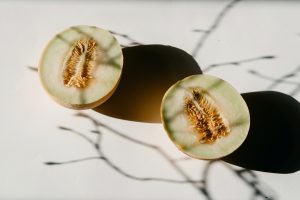
If you want to pick the perfect sweet cantaloupe, there are several tips that you should keep in mind. First and foremost, it’s important to shop at the right time. Cantaloupes are a summer fruit and are typically harvested from June through September. The peak of the cantaloupe season is July and August, so this is the best time to find the freshest and ripest fruit.
When shopping for a cantaloupe, you should also consider the weight. A ripe cantaloupe will be heavy for its size, which indicates that it’s filled with sweet and juicy flesh. You should also check the stem and blossom ends of the cantaloupe. The stem should be slightly soft and yield when pressed, while the blossom end should be slightly depressed, which is an indication that it’s fully matured.
Avoid cantaloupes with bruises or soft spots, as these are signs of over-ripeness or damage. Lastly, it’s important to store your cantaloupe properly to maintain its freshness. You should store it in a cool, dry place and avoid stacking it on top of other fruits or vegetables.
By following these tips, you can select a perfectly ripe and sweet cantaloupe that’s ready to enjoy.
Proper storage of Cantaloupes
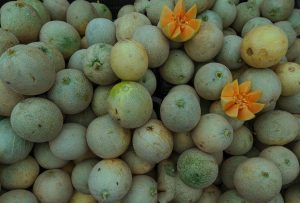
Once you have found a perfectly ripe and sweet cantaloupe, it’s important to know how to store it properly to maintain its freshness and flavor. The best way to store cantaloupes is to keep them at room temperature until they are fully ripe. Once the cantaloupe is ripe, it can be stored in the refrigerator to extend its shelf life.
It’s important to keep the cantaloupe away from other fruits and vegetables, as they can release ethylene gas, which can speed up the ripening process and cause the cantaloupe to become overripe. You should also avoid washing the cantaloupe until you are ready to eat it, as excess moisture can cause it to spoil more quickly.
If you’ve cut into the cantaloupe but aren’t able to finish it all, you can wrap the remaining pieces tightly in plastic wrap and store them in the refrigerator for up to three days. By storing your cantaloupe properly, you can ensure that it stays fresh and delicious for as long as possible.
Common mistakes to avoid when selecting a Cantaloupe
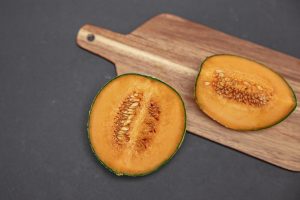
While selecting the perfect cantaloupe may seem like a simple task, there are some common mistakes that people make that can lead to disappointment in their fruit selection. One mistake to avoid is relying solely on color to determine ripeness.
While the color of the skin can provide some indication of ripeness, it’s not the only factor to consider.
Cantaloupes can still be unripe or overripe even if they have the right color. Another mistake is pressing too hard on the fruit when checking for ripeness. While it’s important to check the stem and blossom ends for texture, pressing too hard can actually cause bruising and damage to the fruit. Instead, use a gentle touch when checking the texture of the cantaloupe.
Lastly, it’s important to avoid choosing cantaloupes with blemishes, such as cuts or bruises. These blemishes can indicate that the fruit is damaged and may be overripe or not as fresh. By avoiding these common mistakes, you can ensure that you select a perfectly ripe and delicious cantaloupe that will satisfy your taste buds.
Frequently Asked Questions
A fully ripe cantaloupe should have a smooth, slightly waxy skin that is yellowish-orange or golden in color. When you press your finger into the skin, it should give slightly and then bounce back. The stem end of the melon should also be slightly soft to the touch.
Additionally, a ripe cantaloupe will have a sweet aroma and when cut open, the flesh should be juicy and orange in color.
When selecting a cantaloupe, look for one that is heavy for its size with no bruises or cuts on its skin.
Avoid any melons with soft spots or moldy patches as they indicate that the melon is overripe. To ensure you are getting a ripe melon, check for signs of ripeness such as those mentioned above before purchasing it from the store.
Yes, cantaloupes get sweeter as they ripen. As the melon matures, its sugar content increases and it takes on a softer texture. The best way to tell if a cantaloupe is ripe is to look for a few key signs.
First, check for a sweet smell coming from the stem end of the fruit. If it smells like honey or sweet melon, it’s ready to eat! Second, look for a golden color on the skin near the stem end; this indicates that the melon has been exposed to sunlight and has had time to ripen. Finally, press lightly against the skin of the cantaloupe; if it yields slightly to pressure, then it’s ripe and ready to be eaten!
Yes, cantaloupe does get sweeter after cutting. This is because when the melon is cut, the natural sugars inside of it are exposed to the air and begin to oxidize. As this process occurs, the sugar content in the cantaloupe increases, making it sweeter than before it was cut.
When selecting a cantaloupe for purchase, look for one that is heavy for its size and has a sweet smell. You can also gently press your thumb into the skin of the melon; if it yields slightly then you know it’s ripe and ready to be eaten.
Once you have a ripe cantaloupe, store it in the refrigerator until you’re ready to use it. When you’re ready to eat it, cut open the melon and enjoy its sweet flavor!
The amount of time it takes for a cantaloupe to fully ripen depends on several factors, including the variety of cantaloupe and the climate in which it is grown. Generally speaking, most cantaloupes take between 7-14 days to ripen after they are harvested.
If you want to speed up the ripening process, you can place your cantaloupe in a paper bag with an apple or banana for a few days. The ethylene gas produced by these fruits will help the cantaloupe ripen more quickly. You should also check your cantaloupe every day during this time and remove any that have become overly ripe.
When a cantaloupe is ripe, its skin will have a yellowish hue and it will give off a sweet aroma. If you press gently on the blossom end of the fruit, it should give slightly when ripe.
Why are my cantaloupe not sweet?
If your cantaloupes are not sweet, there could be a few reasons why. The most common reason is that the melon was picked too early. If the melon is picked before it’s ripe, it will lack sweetness and flavor.
Another possible reason is that the melon wasn’t given enough time to ripen after being picked. If you leave the melon out on the counter for a few days, it should become sweeter as it ripens.
Finally, if your cantaloupe was grown in poor soil or in an area with extreme temperatures, that can also affect its sweetness. To ensure your cantaloupes are sweet and flavorful, look for ones with a golden hue and check that they have a fragrant smell when you buy them.
Should you water cantaloupe plants everyday?
Generally speaking, it is not recommended to water cantaloupe plants every day. The frequency of watering should be based on the soil type and weather conditions in your area. In general, you should check the soil moisture level before watering to determine if it needs water. If the soil is dry, then give the plant enough water to moisten the soil but not make it soggy.
For optimal growth, cantaloupe plants need 1-2 inches of water per week during their growing season. If there is no rain during that time, then you may need to supplement with irrigation. However, be careful not to overwater as this can lead to root rot and other diseases.
In addition to proper watering, make sure that your cantaloupe plants are getting enough sunlight and nutrients for optimal growth. Fertilize your plants every 2 weeks with a balanced fertilizer such as 10-10-10 or 20-20-20.
Does cantaloupe last longer cut or uncut?
The answer to this question depends on the freshness of the cantaloupe when it is cut. Generally, whole cantaloupes will last longer than cut pieces. This is because once a cantaloupe has been cut, it is exposed to air and bacteria that can cause it to spoil faster.
To maximize the life of a cut cantaloupe, store it in an airtight container in the refrigerator. This will help keep out any contaminants that may cause it to spoil faster. Additionally, make sure to eat the cut pieces within a few days for optimal freshness.
On the other hand, if you are looking for a longer shelf life, then storing an uncut cantaloupe is your best bet. Uncut cantaloupes can typically last up to two weeks when stored at room temperature or up to four weeks when stored in the refrigerator.
Can you ripen a hard cantaloupe?
Yes, you can ripen a hard cantaloupe. The best way to do this is to place the cantaloupe in a paper bag with a ripe banana or an apple. The ethylene gas that is produced by the fruit will help speed up the ripening process of the cantaloupe.
Additionally, you can leave the cantaloupe out at room temperature for several days until it becomes soft and fragrant, which is a sign that it is ripe.
If you need to speed up the ripening process, you can also place your cantaloupe in direct sunlight for a few hours. This will also help to soften and sweeten the melon. However, be careful not to leave it out too long as this could cause it to become overripe and mushy.
Related articles
How to tell if sweet potatoes are bad; Ultimate guide 2023
Egusi (Melon) Seeds: An Underrated Super food
How to preserve pumpkins to last Longer | Simple guide.
Conclusion
In conclusion, selecting a perfectly ripe and sweet cantaloupe is not as difficult as it may seem. By following the tips outlined in this article, you can choose a cantaloupe that is fragrant, symmetrical, and has a slightly rough texture.
Once you’ve selected your perfect cantaloupe, remember to store it properly in a cool, dry place. A perfectly ripe cantaloupe is a refreshing and healthy addition to any meal, and with these tips, you can enjoy its delicious sweetness to the fullest.
So, the next time you’re at the grocery store or farmer’s market, keep these tips in mind and select the best cantaloupe that you can find.

Leave a Reply
You must be logged in to post a comment.